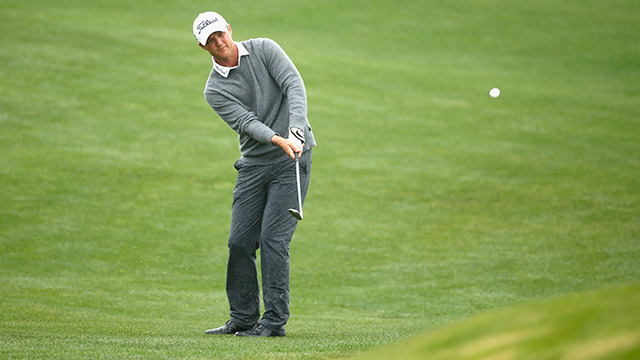NEWS
Lesson Learned: Short game in the rain

Not everybody has the short-game touch of a Matt Jones, who chipped in from more than 40 yards out Sunday to win a rainy Shell Houston Open playoff against Matt Kuchar.
But you can learn to minimize mistakes when you’re playing on a wet course, thanks to some excellent advice from PGA professional Brian Conley.
Conley, PGA Head Professional at the Legacy On Lanier Golf Club in Buford, Ga., said most amateurs worry about either hitting chips too fat or too thin when the grass gets wet.
PLAYOFF WINNER: Watch Matt Jones chip in to win Shell Houston Open
“Under soft conditions, your club is more prone to dig into the ground,” Conley said. “Or you get so wrapped up in avoiding that ‘fat’ chunk, you end up blading the ball and watching it scream over the green into who knows what.”
That’s because your club is designed to bounce under normal, dry conditions. But that’s not at all desirable in the wet. Instead, Conley suggested trying not to pick the ball cleanly. Take an aggressive stroke and try to hit the ball first before hitting the turf.
In order to do that, Conley said you’ll have to make some changes to your stance, your club selection and the angle of the club face.
MORE CHIPPING TIPS: Video instruction on the "rule of thirds"
“Play the ball just a touch farther back in your stance and you may even address the ball more closely so that the heel is slightly off the ground at address,” Conley said. “For me, that means about half a ball farther back. Again, this ensures you’re contacting the ball first.
“Then take a little extra lofted club -- perhaps a sand wedge rather than a pitching wedge or a lob wedge rather than a sand wedge -- and close the face a little.”
However, Conley cautioned about one thing to avoid.
“Don't close or shut down the toe at address and through the shot,” he said.
PGA PROFESSIONALS: Find expert instruction near where you live
What all that does is deloft the shot, allowing the ball to come out lower but also allowing it to check up. That has to do with friction. A wet ball making contact with wet grass should spin more — because of the friction between the two — so you can throw it a little closer to the hole than normal, or even past, if you start learning how to make the ball back up.
Do the same thing as you would normally do when chipping: Keep your hands in front of the ball and always moving left, for right-handed golfers. Obviously, the other way around if you’re a lefty.
If you follow the steps correctly, “your club can, and should, contact the ground … only it will do that after you've hit the ball,” Conley said.
“I’d suggest practicing this shot to get a good feel for your distances. But this technique is easy to implement into your game and will help you lower scores when playing on a wet course.”
Rain gear. Dry towels. Umbrella. And some great tips for improving your short game. All should be on your checklist the next time gray skies threaten your golf game.
